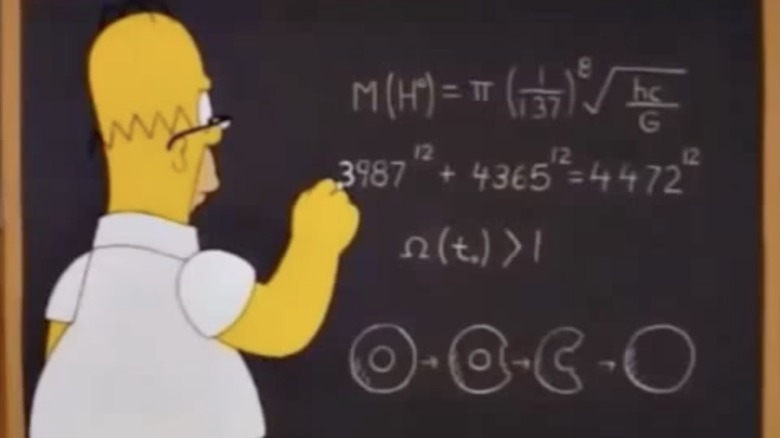The Simpsons Episode That Came Close To A Major Scientific Breakthrough
Over the course of 33 seasons of "The Simpsons," the series has been praised for its cleverness — and for being so smart that it even developed a knack for predicting the future. IGN has pointed out that the show foreshadowed the COVID-19 pandemic and murder hornets in the first episode of Season 4, along with the presidency of Donald Trump in its 11th season (circa 1999-2000), Disney's purchase of 20th Century Fox in its 10th season, and even the ending of "Game of Thrones" in Season 29 (in 2017, almost two years before the final episodes of the HBO show aired).
How to explain this uncanny ability? Showrunner Matt Selman said (via IGN), "If you just do more episodes for more decades than all the other shows, you're gonna get more predictions right. And we really have all the other shows beat when it comes to decades." Whether he's right or not, the future-predicting phenomenon has been so well documented that there's going to be an episode explaining it in the show's 34th season (via Deadline).
One memorable example of the prescience of "The Simpsons" took place in 1998, when Homer Simpson, inspired by Thomas Edison, took to inventing things and discovered something important — a scientific breakthrough that, in real life, didn't happen until more than a decade later.
The almost-breakthrough was documented in an equation Homer wrote on a blackboard
The discovery is a bit of an Easter egg in the 1998 episode "The Wizard of Evergreen Terrace," as viewers of the episode could very well have watched the whole thing without noticing it. As Homer is trying to emulate Thomas Edison's prolific inventiveness, he is seen looking at several short equations on a blackboard. In the first one, the first symbols in the equation, "M(Ho)," refer to the Higgs-Boson particle, an elementary particle first proposed in 1964 (via CERN).
"The equation is a playful combination of various fundamental parameters, namely the Planck constant, the gravitational constant, and the speed of light," Simon Singh said in his 2013 book "The Simpsons and Their Mathematical Secrets." "If you look up these numbers and plug them into the equation, it predicts a mass of 775 giga-electron-volts (GeV), which is substantially higher than the 125 GeV estimate that emerged when the Higgs boson was discovered in 2012."
Singh says that 775 GeV was not a bad guess for an amateur, though, considering that Homer was calculating this 14 years before CERN physicists were able to track down and confirm the particle's existence using the Large Hadron Collider in Switzerland. In an interview with The Independent, he says Homer's number is "only a bit larger than the nano-mass of a Higgs-boson actually is," which is actually an amazing feat.
The Simpsons may have more math references than any other TV show
According to Simon Singh, this predilection for math in "The SImpsons" is no accident. He notes that in the 1st season, the core writing team behind the show consisted of eight super-smart writers who wanted the show to display a similar intelligence. "They were keen to create scripts that included references to sophisticated concepts from all areas of human knowledge, and calculus was particularly high on the list because two of the writers were devotees of mathematics," he says in "The Simpsons and Their Mathematical Secrets."
Those writers were Mike Reiss and Al Jean, who were promoted to executive producers by the 3rd season — and the show continued to hire mathematicians. "They smuggle little bits of mathematics into each episode when we're not looking," Singh explained in a promotional video promoting his book. These references, he said, turned "The Simpsons" into a TV show with more references to math than any other TV series (although he has noted, via Wired, that "Futurama" and "The Big Bang Theory" are up there, too).
Singh says the math in this particular episode was introduced by David S. Cohen, a newer writer who joined "The Simpsons" in the 1990s. He wanted to include scientific equations alongside the math ones, so he contacted a high school friend who had become an astronomer at Columbia University. So the equation in question is likely the work of David Schiminovich, who probably has a great story he tells at parties about his role in one of television's longest-running series.


